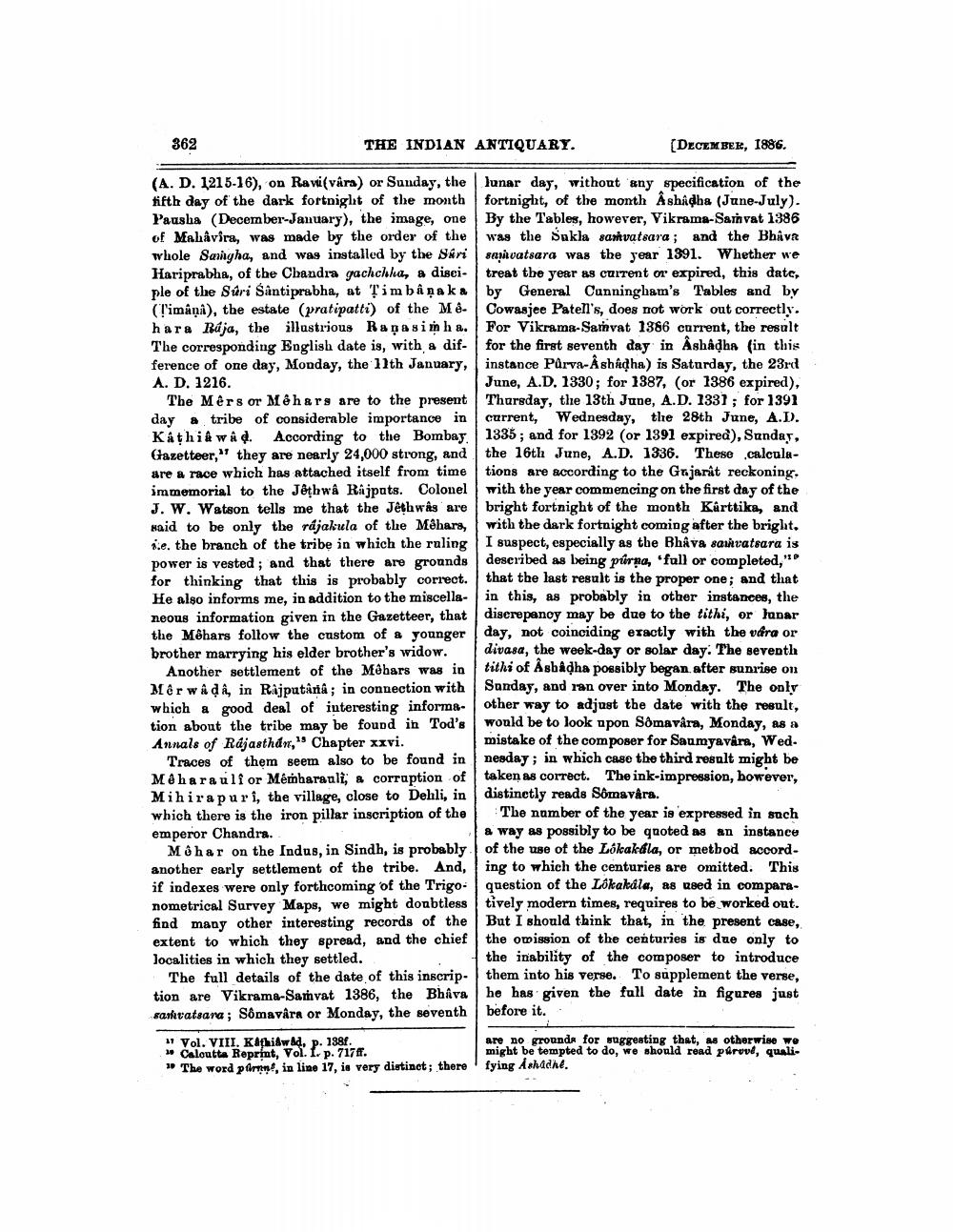________________
362
THE INDIAN ANTIQUARY.
(DECEMBER, 1886.
(A. D. 1215-16), on Ravi(vara) or Sunday, the lunar day, without any specification of the fifth day of the dark fortnight of the month fortnight, of the month Åshadba (June-July). Pausha (December-January), the image, one By the Tables, however, Vikrama-Samvat 1386 of Mahavira, was made by the order of the was the Sakla samvatsara ; and the Bhava whole Sangha, and was installed by the Seri samvatsara was the year 1391. Whether we Hariprabha, of the Chandra gachchha, a disci- treat the year as current or expired, this date, ple of the Súri Santiprabha, at Tim banaka by General Cunningham's Tables and by (l'imaņi), the estate (pratipatti) of the Me. Cowasjee Patell's, does not work out correctly. hara Rúja, the illustrious Ranasinha. For Vikrama-Samvat 1386 current, the result The corresponding English date is, with a dif- for the first seventh day in Ashâdha (in this ference of one day, Monday, the 11th January, instance Pârva-Ashkha) is Saturday, the 23rd A. D. 1216.
June, A.D. 1330; for 1387, (or 1386 expired), The Mêrs or Méhars are to the present Thursday, the 13th June, A.D. 1337; for 1391 day a tribe of considerable importance in current, Wednesday, the 28th June, A.D. Káthiê wê d. According to the Bombay. 1335; and for 1392 (or 1391 expired), Sunday, Gazetteer," they are nearly 24,000 strong, and the 16th June, A.D. 1336. These calculaare a race which has attached itself from time tions are according to the Gujarat reckoning. immemorial to the J&thwâ Rajputs. Colonel with the year commencing on the first day of the J. W. Watson tells me that the Jethwâs are bright fortnight of the month Kürttika, and said to be only the rájakula of the Méhars, with the dark fortnight coming after the bright, vie. the branch of the tribe in which the ruling I suspect, especially as the Bhåva sarkvatsara is power is vested ; and that there are grounds described as being púrna, 'full or completed, "" for thinking that this is probably correct. that the last result is the proper one; and that He also informs me, in addition to the miscella- in this, as probably in other instances, the neous information given in the Gazetteer, that discrepanoy may be due to the tithi, or lapar the Méhars follow the custom of a younger day, not coinciding eractly with the vara or brother marrying his elder brother's widow. divasa, the week-day or solar day. The seventh
Another settlement of the Môbars was in tithi of Asbadha possibly began after sunrise on Mér widA in Rajputana; in connection with Sunday, and ran over into Monday. The only which a good deal of interesting informa- other way to adjust the date with the result, tion about the tribe may be found in Tod's would be to look upon Somavára, Monday, as a Annals of Rajasthan," Chapter xxvi.
mistake of the composer for Saumyavara, Wed. Traces of them seem also to be found in nesday; in which case the third result might be Maharauli or Mérharauli; a corruption of taken as correct. The ink-impression, bowever, Mihirapuri, the village, close to Dehli, in distinctly reads Somavára. which there is the iron pillar inscription of the The number of the year is expressed in such emperor Chandra.
a way as possibly to be quoted as an instance Mô har on the Indus, in Sindh, is probably of the use of the Lókakala, or metbod accord. another early settlement of the tribe. And, ing to which the centuries are omitted. This if indexes were only forthcoming of the Trigo- question of the Lókakila, as used in comparanometrical Survey Maps, we might doubtless tively modern times, requires to be worked out. find many other interesting records of the But I should think that, in the present case, extent to which they spread, and the chief the omission of the centuries is due only to localities in which they settled.
the inability of the composer to introduce The full details of the date of this inscrip- them into his verse. To supplement the verse, tion are Vikrama-Samvat 1386, the Bhava he has given the full date in figures just sanhvatsara; Sômavara or Monday, the seventh before it. 11 Vol. VIII. KáthidwM, p. 1888.
are no grounds for suggesting that, as otherwise we * Caloutta Reprint, Vol. 1. p. 717ff.
might be tempted to do, we should read parove, quali» The word panni, in line 17, is very distinct; therefying Aahadhe.




